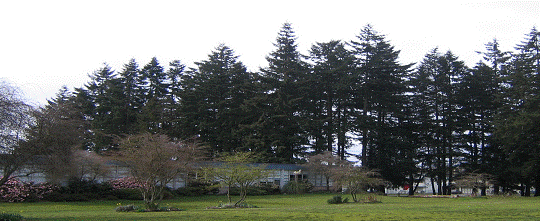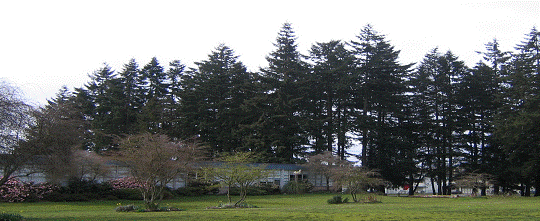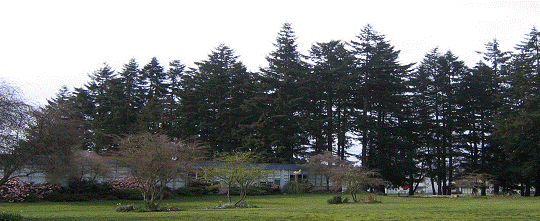
Threatened NW Tree Grove at Ingraham High School
Last Friday I attended the BEX (Building Excellence) Programs Oversight Committee that is supposedly helping oversee the latest construction projects being done by the Seattle Public Schools. I went to correct errors in their meeting notes from a previous meeting. I was graciously given an opportunity to present my concern regarding the lack of public involvement in siting and designing the Ingraham High School Construction Project that is moving ahead to cut down 62 large Douglas Fir and western red cedar trees, most over 50 years old and many over 100 feet tall, as well as up to 22 madrone trees
While the committee was responsive to realizing that there was a lack of public notification and involvement on the front end, their response seemed to center on the fact that they needed to do a better job in the future addressing public involvement and environmental concerns. The present situation seems to be a classic group think process. No one seems to want to be the one to say maybe they need to look at alternative designs because that would stop the forward momentum and no one wants to be the one to say now that maybe they messed up and they should step back and site the project on an alternative site.
It doesn’t matter that it is now obvious that no alternative designs or sites were seriously considered. In fact at the August 27, 2007 Ingraham High School Design Committee meeting #2, the recently published minutes have the statement that “Building Scheme A with new addition at the west end is preferred.”
When I recently asked to see any blueprints or budgets or even serious sketches of alternative designs to the west addition, I was told that none were available. A formal request for alternative designs and budgets to the Legal Department of the Seattle School District brought the response that none exist.
Ironically the guy dealing with the environmental review process for the Seattle School District is Ron English who reminded me recently that he was involved in defending WPPSS’s (Washington Public Power Supply System) building its 5 ill fated nuclear power plants many years ago. Back in 1981 when he was an attorney for WPPSS, I was the sponsor of Initiative 394 to require that there be a public vote before they could issue more public bonds to be paid for by ratepayers to continue building the projects. The initiative required for the first time that WPPSS do cost effectiveness studies on the projects to determine whether or not there were cheaper alternatives to generating energy than building all 5 plants. This was something WPPSS never did before starting to build its 5 nuclear power plants.
In some ways the Seattle School District, while much more benign than WPPSS, has approached building the new addition to Ingraham High School in the same secretive way WPPSS went about building its nuclear power plants. The Seattle School District did a non public design review process. It started last year with the Ingraham High School Principal selecting a few teachers and a couple of parents to meet with consultants and Seattle School Administration people to sit on a school design team that was involved in selecting a site and design for the new project. The design team did not hold public meetings or seek public input. It was only in March, 2008 long after the meetings were held that brief notes of the minutes were posted on the school’s website. The meetings started back in July of 2007.
Neighbors, other community members and concerned citizens were not given a chance to give input on the project or even follow its progress until after the site was chosen and the architectural firm had drawn up the blueprints. When neighbors first heard what was happening – that the school design team, consultants and Seattle School District Administrators had made their decision – they were basically told it was too late to look at any alternative designs or question the decision of the in-house committee. The first public neighborhood meeting was on March 18, 2008 the day before comments were due on the Environmental Checklist that was used to reach a Determination of Non-significance by the School District’s in house environmental Lawyer, Ron English.
The parallels with WPPSS are obvious to me- they did not seriously look at alternatives, either in terms of environmental costs or for comparison of building costs. They only seriously considered one site, the same as WPPSS only considered building nuclear plants. WPPSS treated its ratepayers the same way as the School District did in this process – WPPSS allowed them the opportunity to respond after the meeting was over and the Board had taken their votes on agenda items. It was obvious that the public’s opinion did not matter.
Being given an opportunity by the Seattle School District to make comments after the site and design decision is made allows for only token public involvement. We repeatedly hear the argument that we’ve already spent money to come up with a design and we don’t want to waste it by looking at alternatives now. WPPSS made the same kind of argument, as they continued to issue more and more bonds for what eventually became the largest municipal bond default in US history. Continuing to spend more money does not make the original decision any more right. Being unwilling to re-evaluate projects as to their feasibility and desirability as concerns arise is a sign of rigidity and a shirking of public responsibility. Saying we will do better next time does not make it right this time.
The following is the letter I submitted to the BEX committee. Originally it by some committee members was suggested to add the letter to the meeting minutes but the representative from the UW sitting on the committee thought that was going too far since I was advocating a position (they aren’t?) and got the committee to agree to only amend the minutes. Heaven forbid if the public read what I had to say at a public meeting of a committee of the Seattle Public Schools. Anyway here’s the letter:
Correction needed to Meeting Notes
of March 14, 2008 BEX Programs Oversight Committee
Under Project Updates for Ingraham High School it says “Numerous community meetings were held.” This is not true. No community meetings had been held to this point. The first community meeting anyone heard of was a March 18, 2008 open house and it was poorly attended because of a messed up mail program that sent a few people 29 copies each of the meeting notice and the rest of the neighbors got no notice, including those right across the street from the proposed construction site. A second and final meeting was held April 24, 2008. These were all after a design and site had already been picked without community involvement.
At the April 24th meeting four sites were noted on a map, on the north, east, south and west side of the school. This was the first time neighbors and others in the community heard any discussion of other sites besides a north site mentioned in the geophysical report and dismissal of the north site when neighbors asked why it was not being considered. Besides the site in the west grove of trees, the site on the east side was in a second grove of trees, while the south site was where the tennis courts are and the north site is actually on a grassy lawn that does not require any large trees to be cut down.. So to say that “even more trees would have to be removed if another location had been selected” is also factually wrong.
It is important to note that over 700 citizens have signed a petition asking that the school district build on an alternative site like on the North side of the school that does not require destroying 62+ fifty year old 100 foot tall Douglas fir and western red cedar trees, as well as up to 22 madrone trees. The tree cover in Seattle was listed as 40% in 1972 and last year was 18%. The Douglas fir madrone forest area on the west side of Ingraham is becoming rare in the city and destroying over half the forest would be a loss for Seattle and the school district that is not necessary.
What is strange here is that the North site is actually discussed as a building site for Ingraham in its long range plans. The community and neighbors are upset that they were excluded from the process and are still viewed as only a nuisance. Yet the public that was given no chance to be meaningfully involved in a timely fashion are the ones who will be paying off the bonds for the projects.
Groups like the Haller Lake Community Club, the Seattle Community Council Federation and the 46th District Democrats have all taken positions questioning the lack of community involvement, opposing cutting down over half the forest area and supporting an alternative design. Signers of the Save the Trees petition included King County Executive Ron Sims, Washington State Senators Ed Murray and Ken Jacobsen and State Representatives Mary Lou Dickerson and Phyllis Kenney.
Support is strong for preserving the trees and the public does not understand why the Seattle School District seems to think they can destroy so many trees and think it is not significant or that they did not feel the need to consult with neighbors and others before going ahead with a design that significantly destroys so much of a unique urban forest, significantly altering both a school campus and the neighborhood.
The Seattle School District needs to step back and give an alternative design serious consideration or it stands to lose serious credibility as a responsible member of the larger community. Building on the current proposed site will destroy many trees that have been growing for over 50 years and that given time will be exceptional trees, Just as educating students takes time, trees do not reach maturity in just a few years. And serious questions exist as to the viability of the remaining trees because of possible severe root damage and changed wind dynamics at the site.
The Seattle School District has an opportunity to step back, take a second look and act in a more environmentally responsible way. It is not easy to do that but it would set a great example for Seattle students to see the Seattle Public Schools change course and adapt to changing times, needs and circumstances and put a greater emphasis on preserving our natural habitat in which we live. It is a great lesson to impart to our future leaders – that it is possible to change course and be more environmentally conscious and responsible.
Steve Zemke
Save the Trees
2131 N 132nd St
Seattle, WA 98133
www.MajorityRules.org/blog
dated Friday, May 9, 2008






